
Are we back to 2011?
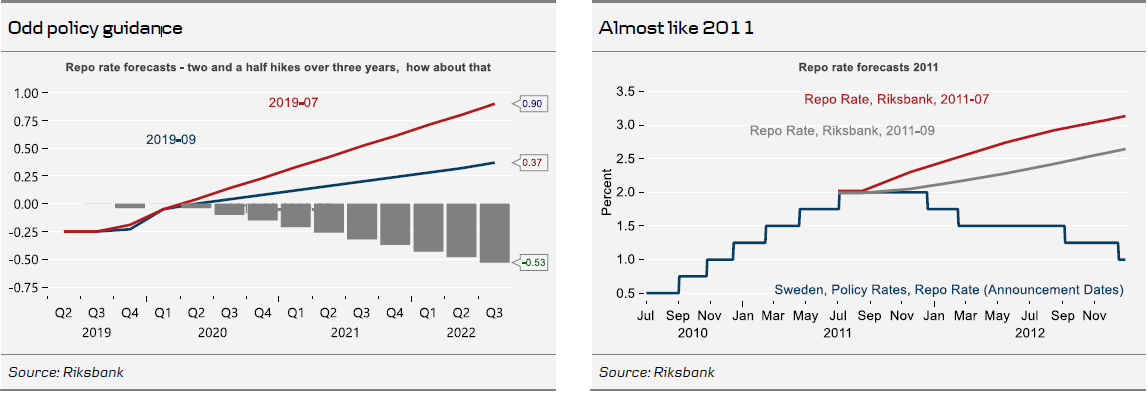
We think the Riksbank took most of us by surprise by sticking to the view that it is appropriate to hike around the turn of the year. Instead, the new repo rate path is distinctly flatter than in July. The end point (Q3 22) is 53 basis points lower than in July. The revised repo rate path implies about 2.5 rate hikes (62bp) over a period of three years. What kind of monetary policy guidance is this? In our minds, it is not credible.
It is almost as though we are back in 2011. In September that year, the Riksbank flattened the repo rate path compared with the July forecast as global growth deteriorated but was nevertheless planning for hikes throughout 2012. Three months later, in December, after the ECB had started to ease, the Riksbank delivered the first of a series of cuts (see righthand chart above).
We simply cannot understand the rationale behind the sharp flattening of the repo rate path. It would have been more sensible to keep the steepness while postponing the path as the economy weakens. Still, in our view, this is a first step towards postponing rate hikes in coming meetings and eventually cutting the repo rate it in early 2020. Riksbank appears to take little notice of the implications of a weakening labour market. In particular, we find this statement fascinating: ‘…the rate of wage increases is expected to rise over the next few years, among other things because the wage bargaining round in 2020 will take place in a situation where the labour market has been strong and inflation close to 2 per cent for several years’. We believe the opposite. In a deteriorating labour market, we would be surprised to see higher wage growth.
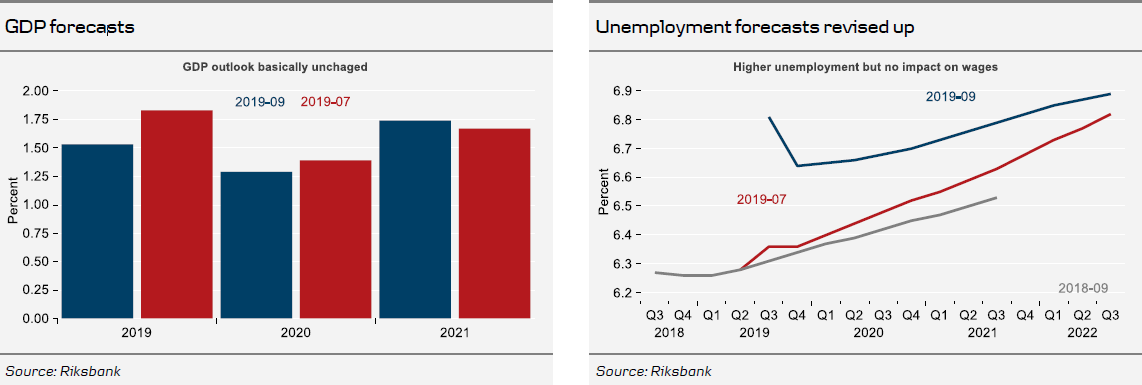
In many ways, the analysis presented in the monetary policy report is, in our view, weird. It acknowledges that the Fed has eased (and that the market expects more to come) and that the ECB has made clear the need for more stimulus. Growth forecasts for the eurozone and US are basically unchanged though. This, in turn, is because the central banks are easing policy. We guess this is one way to look at it.
Sweden is in a phase of slowdown but economic conditions remain strong. However, resource utilisation is set to normalise a bit more rapidly than we previously thought. The report acknowledges that the labour market looks somewhat weaker and the unemployment forecast has been revised up. The Swedish GDP forecast is not changed in any meaningful way.
Again, we have a hard time piecing together the different parts of this report. Maybe the Riksbank is buying time, as trade conflicts and Brexit could be resolved and maybe then things could look better, so why not wait, or maybe the policy decisions and forward guidance are a compromise. We would not be surprised if the views of hawks and doves were very divided this time around. Henry Ohlsson may well have argued again for hiking now, while Per Jansson might have made a case for the opposite. So, the way to reach a compromise was to keep the rate hike around the turn of the year intact but at the same time to flatten the curve.
Nonetheless, unless economic data, internationally and in Sweden, turn for the better, we find it hard to believe that the Riksbank will actually hike. Instead, we keep our call that a rate cut early in 2020 looks more probable.
August inflation data
The key driver for August inflation is a seasonally typical correction (downward) in airfares, with prices moving up sharply in June-July and falling back in August. Food prices have gone up a lot this year. The July figure (2.1% m/m) was by far the highest for at least 25 years. We assume a correction of -0.5% in August. This is in line with August 2018, so maybe there is a downside risk to this. Our CPIF estimate this time does not deviate from that of the Riksbank to an extent that is worth mentioning.
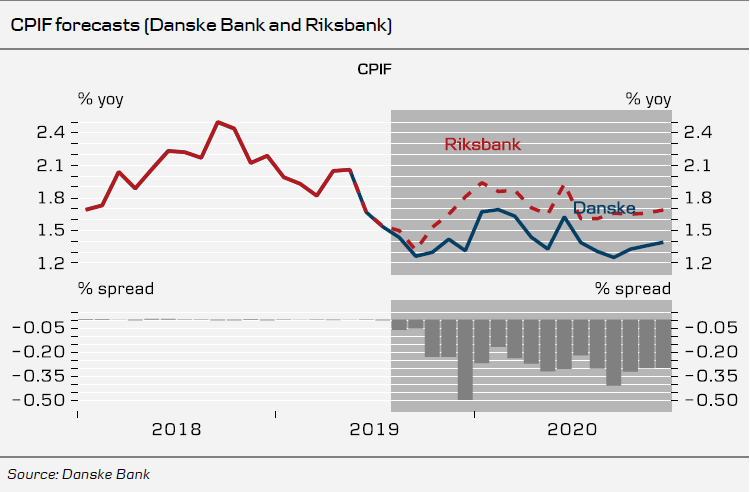
Events in Sweden
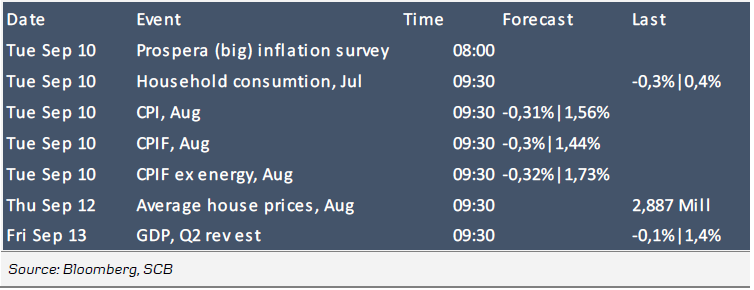
Hawkish Ingves may provide a selling opportunity in the SE
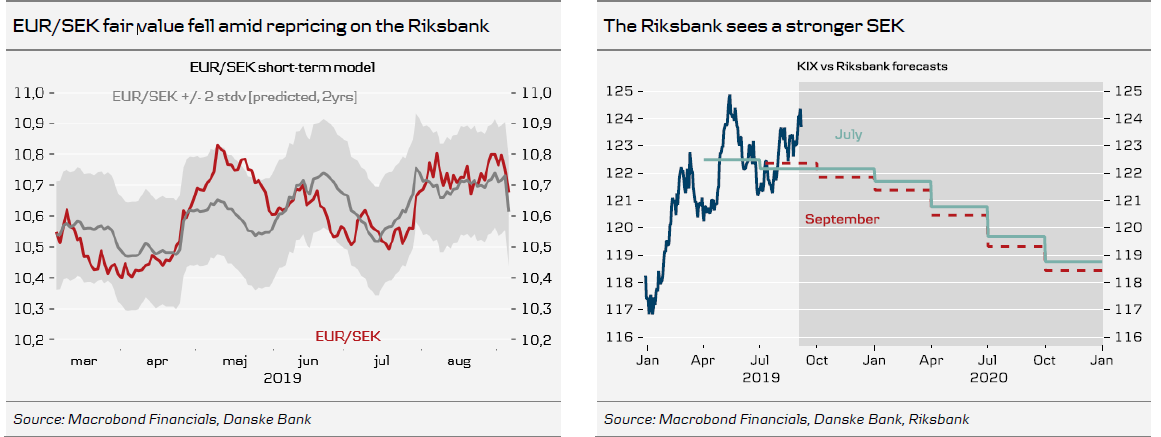
EUR/SEK immediately fell from 10.74 to 10.66 but, at the time of writing, the cross has recovered to around 10.69. The message was not as soft as we and market had expected and thus the fall makes perfect sense. Fair value according to our short-term model fell from around 10.70 to just above 10.60. Given that the money market swiftly removed 7bp of the 17bp of cuts until April next year, the net reaction so far in the FX market appears somewhat muted. One reason may be the substantial flattening of the rate path, which supports our view that the Riksbank will remain one of the softest central banks around the globe. Yesterday’s decision may be viewed as relatively hawkish compared with an ECB measures next week and temporarily weigh on EUR/SEK. We still think the next move is a cut and, as such, we continue to see EUR/SEK as a buy on dips, keeping our 1M and 3M (NYSE:MMM) targets at 10.70 and 10.80. Technically, there is strong support around the 10.60 area. For what it is worth, the Riksbank’s new KIX forecast implies a stronger SEK ahead. However, in July, it expected KIX to rise near term (weaker SEK); now it expects KIX to fall (stronger SEK). Well, it got the SEK’s first reaction right.
Open strategies

